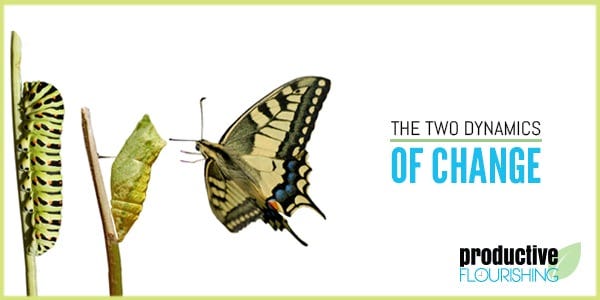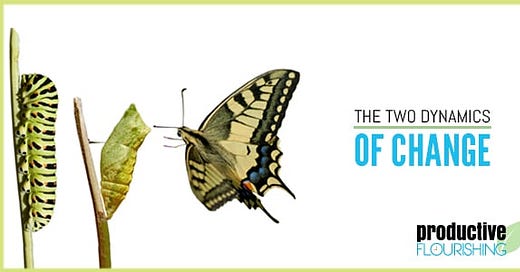The Two Dynamics of Change

We often hear two seemingly contradictory statements from change agents:
A series of small steps is the best way to get something done.
You can't cross a chasm in two small steps.
Both are true, but neither are sufficient at fully capturing reality. There are two dynamics of change that we have to consider. The first dynamic is what I'm calling the stepping dynamic, and the second dynamic I'm calling the tipping dynamic. Both are real facets to the evolution of ourselves and the world. Consider how an avalanche builds. Proponents of the stepping model would show that it's just a series of snowflakes that stack on top of each other, but that doesn't quite capture the dynamic tip that happens at the moment the snow starts moving. On the other hand, proponents of the tipping model often don't account for the fact that without all those snowflakes, the tip would never occur. The real challenge isn't the conceptual distinction between the two dynamics of change, but, rather, it's recognizing when we should step and when we should make room for a tip.
Get to Stepping!
If you guessed that I'm a proponent of the stepping model, you get half a cookie. One of the reasons I'm such an advocate of small steps is because it's the dynamic that we have the most control and influence over. We can't single-handedly manifest the conditions for a tipping point, but we can show up and set those conditions through a series of small actions. Consider the fact that you don't become a true master in your craft all at once. There's a long trail of experience, practice, and evaluation that goes into mastery, and without the butt-in-seat time, you'll never get there. Yet many people never start the long trail of mastery because they (correctly) assess that they're not good at what they're trying to master. No one starts out being good at anything. Aside from the marginal advantages we get from our genetics, everything is learned. And, for someone to learn, they have to be taught, either by someone else or by themselves. The former tends to be more successful, but it's sometimes not a live option. Yet, at some point, taking small steps gets in the way of the metamorphosis that needs to happen. One day you wake up and you are a real expert, and not recognizing that keeps you from making the contributions that you can make.
If you’re doing your best work, you’ll always be on the edge of your capabilities and comfort levels. Imagine a Venn diagram, with your current capabilities in the left circle and your areas of incompetence in the right circle. Learning and growth happens right where those two intersect. Doing your best work will thus require you to constantly be on the verge of failing.
A butterfly doesn't need to cling to the same branches it did as a caterpillar.
How a Caterpillar Takes to the Air
The tipping dynamic of change is so challenging due to how radical it is. Take, for instance, the person who has recently become a celebrity. Last month, she was just another person trying to be heard and seen, and now everyone wants some of her. Old habits, perspectives, and relationships change regardless of whether she means for them to. What's often forgotten at this phase is all the steps that set up the metamorphosis. That new celebrity forgets that it was her fans and support network that enabled the tip, or that now all-star business forgets that it was a strong customer service and over-delivery ethic that made them who they are. This happens time and time again, and what separates the good-for-a-minute people, projects, and causes and the truly great people, projects, and causes is that the latter makes room for the metamorphosis and then get back to stepping. It would have been easy for Michael Jordan to rest on the fact that he dominated the court. It would have been easy for Apple to stop innovating with the iPod and play it out. But Michael kept practicing, and Apple keeps innovating. That's what makes them world-class. They step, tip, reassess, and step all over again. It's true that you can't cross a chasm in two steps, but you have to get there in the first place.
Know Which Dynamic You're In
There are times when you should step, and there are times when you need to make room for a tip. If you feel like you're holding back an avalanche, it's probably a good indication that you somehow need to make room for a metamorphosis. Let the dam break and see what happens. If you feel like you're looking at a long trail that leads to a mountain in the distance, you probably just need to continue taking those steps for now. It's okay to be where you are, but you don't have to stay there. Both dynamics are a part of the world, and there's a time and place for both. One isn't any better than the other, either. The trick is figuring out which dynamic is the most appropriate to where you are. I'll leave you with two questions:
If you need to step, do you know what steps to take?
If it's time for a tip, how will you make room for it?
If you want to learn more about figuring out your next steps, or how to make room for the things you need to do, Start Finishing will guide you through these dynamics of change.




